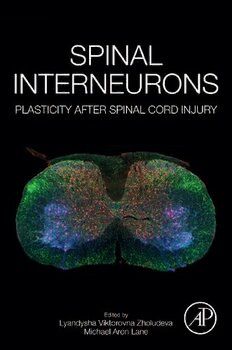
Spinal Interneurons: Plasticity after Spinal Cord Injury PDF
Preview Spinal Interneurons: Plasticity after Spinal Cord Injury
Spinal Interneurons Plasticity after Spinal Cord Injury This page intentionally left blank Spinal Interneurons Plasticity after Spinal Cord Injury Edited by Lyandysha Viktorovna Zholudeva Gladstone Institutes, University of California, San Francisco, CA, United States Michael Aron Lane Drexel University, College of Medicine, Department of Neurobiology & Anatomy, and the Marion Murray Spinal Cord Research Center Philadelphia, PA, United States AcademicPressisanimprintofElsevier 125LondonWall,LondonEC2Y5AS,UnitedKingdom 525BStreet,Suite1650,SanDiego,CA92101,UnitedStates 50HampshireStreet,5thFloor,Cambridge,MA02139,UnitedStates TheBoulevard,LangfordLane,Kidlington,OxfordOX51GB,UnitedKingdom Copyright(cid:1)2023ElsevierInc.Allrightsreserved. Nopartofthispublicationmaybereproducedortransmittedinanyformorbyanymeans, electronicormechanical,includingphotocopying,recording,oranyinformationstorage andretrievalsystem,withoutpermissioninwritingfromthepublisher.Detailsonhowto seekpermission,furtherinformationaboutthePublisher’spermissionspoliciesandour arrangementswithorganizationssuchastheCopyrightClearanceCenterandtheCopyright LicensingAgency,canbefoundatourwebsite:www.elsevier.com/permissions. Thisbookandtheindividualcontributionscontainedinitareprotectedundercopyrightby thePublisher(otherthanasmaybenotedherein). Notices Knowledgeandbestpracticeinthisfieldareconstantlychanging.Asnewresearchand experiencebroadenourunderstanding,changesinresearchmethods,professional practices,ormedicaltreatmentmaybecomenecessary. Practitionersandresearchersmustalwaysrelyontheirownexperienceandknowledgein evaluatingandusinganyinformation,methods,compounds,orexperimentsdescribed herein.Inusingsuchinformationormethodstheyshouldbemindfuloftheirownsafety andthesafetyofothers,includingpartiesforwhomtheyhaveaprofessionalresponsibility. Tothefullestextentofthelaw,neitherthePublishernortheauthors,contributors,or editors,assumeanyliabilityforanyinjuryand/ordamagetopersonsorpropertyasamatter ofproductsliability,negligenceorotherwise,orfromanyuseoroperationofanymethods, products,instructions,orideascontainedinthematerialherein. ISBN:978-0-12-819260-3 ForinformationonallAcademicPresspublicationsvisitour websiteathttps://www.elsevier.com/books-and-journals Publisher:NikkiP.Levy AcquisitionsEditor:JoslynT.Chaiprasert-Paguio EditorialProjectManager:TimothyJ.Bennett ProductionProjectManager:SelvarajRaviraj CoverDesigner:MilesHitchen TypesetbyTNQTechnologies Dedication to Marion Murray (1937e2018): a leader in spinal cord injury research and a pioneer in advancing CNS plasticity WededicatethisbodyofworktoDr.Marion Murray,PhD,ProfessorEmeritusinthe DepartmentofNeurobiologyandAnatomy atDrexelUniversity,Philadelphia,who passedawayonSeptember9,2018. TogetherwithDr.MichaelGoldberger,a closefriendandcollaborator,Dr.Marion MurrayestablishedtheSpinalCord ResearchCenter(SCRC),nowtheMarion MurraySCRC,atDrexelUniversity.Sheled theresearchactivitiesoftheCenterforover 30years,servedasPrincipalInvestigatorof anexceptionalNIHProgramProjectto createoneofthemostprominent,world- renowned,researchcenters.Sheinspired andmentoredcountlessstudents,fellows andfaculty,publishedmorethan150sci- entificarticlesandreviews,andestablished atraditionofexcellencethatcontinuesto thriveinthecurrentDepartmentof Neurobiologywhichwearepartof. An exemplary scientific leader, Marion fearlessly and passionately tackled vi Dedication challenging problems of spinal cord injury to improve human health becoming part of the legacy of women in science over several generations. She had a “Big Pic- ture” vision coupled with skepticism over established dogma in science, and taught d us constructive criticism be it in pub- d lishing papers or grant applications driving the Center to the highest of standards in research and mentoring. Shepioneeredresearchinspinalcordplas- ticityatatimewhenneuroscientistswere skepticalaboutaxonalsproutingandthe neuroplasticpotentialoftheinjuredspinal cord.Thisbookhighlightshowmuchthe fieldnowreadilyacceptstheideasthat Marionhelpedtolaythefoundationfor.We areextremelygratefulforhavinghadthe chancetointeractwithheratDrexel,which contributedtohowthisbookwasdeveloped. We hope that this book will not only serve asamemorytoMarion’slegacybutwould have been a volume she kept on her office bookshelf, frequently read, and shared with her students asshe oftendid with her other books. We miss you, Marion. Lyandysha V. Zholudeva and Michael A. Lane Editors Contents List ofcontributors xiii Preface xvii Section I e Spinal interneurons motor and sensory neuronal networks 1. The neuronal cell types of the spinal cord StephanieC.KochandArielJ.Levine Introduction 3 Historyofresearchonspinal cordneurons 4 Classificationsystemsforspinalcordinterneuroncelltypes 5 Thedorsalhornneuronsofthespinalcord 10 Theventralhorn neuronsofthespinal cord 16 Futuredirectionsforunderstandingspinalcordneuron types 19 2. Identified interneurons contributing to locomotion in mammals ErikZ.Li,LeonardoD. Garcia-Ramirez,NgocT.B.Haand KimberlyJ.Dougherty Introduction 35 Organizationofspinallocomotorinterneurons 37 Spinalinterneurons withlocomotor functions 41 Transcriptionfactorcodetoidentifyinterneuronpopulations 42 Interneurons inalocomotor framework 49 Plasticityofinterneuronsfollowingspinalcordinjury 53 Futureperspectives 56 3. Decoding touch: peripheral and spinal processing Mark A.Gradwell,ManonBohicandVictoriaE.Abraira Introduction 69 PartI:detectingtouch 70 Whatdocutaneoussensory neuronslooklike? 70 vii viii Contents Theincredible heterogeneityofsomatosensory neurons 71 Aquicksense oftouch:Abfibers 71 Touchencodingbyskinsensoryneurons: anintegrativeview 78 PartII:processingtouchinformationinthespinal cord 81 Touchingthespinal cord:LTMRinputstothedorsalhorn 85 Themiddlemen: neuronsofthedorsalhorn 86 Thespinal circuitsoftouch 92 LTMRcircuits,whatdotheydo? 96 Touchinfluences thewaywemoveandrecover fromspinal cordinjury 97 Futurechallengesanddirectioninunraveling spinalLTMRcircuits 101 4. Spinal interneurons and pain: identity and functional organization of dorsal horn neurons in acute and persistent pain Myung-chulNoh,SuhJinLee,Cynthia M.Arokiarajand RebeccaP.Seal Introduction 117 Molecularorganizationofthedorsalhorn 118 Acutepainsignaling 122 Spinalmechanismsofchronicpain 129 Conclusions 145 5. Cholinergic spinal interneurons PatriciaE.Phelps andAlexaMarieTierno Introduction 159 Cholinergicdorsalhorninterneurons 159 Centralcanalclustercells withinlaminaX 163 Partitioncellsintheintermediategray matter 165 Conclusions 167 6. Spinal interneurons, motor synergies, and modularity SimonF.Giszter,TrevorS.SmithandAndreyP.Borisyuk Introduction 172 Thecomparativeneuroethologyandevolutionaryperspective onsynergy 173 Neuromechanicsperspectivesonmotorsynergies 178 Neuroengineeringwithspinal interneuronsystems 189 Discussionandconclusions 194 Contents ix Section II e Spinal interneurons a role in injury and disease 7. Propriospinal neurons as relay pathways from brain to spinal cord AlfredoSandoval,Jr.,ZhigangHeandBoChen Introduction 207 Direct andindirectpathwaysfromthe braintospinal cord motorneurons 208 Spinalinterneuronspropagatelocomotorcommands from supraspinallocomotorregions 210 DormantrelaypathwaysafterSCI:formationof maladaptiveplasticityininjuredspinal cord 214 Therapeutic strategiesforSCI:utilizing spinalinterneurons 218 Concludingremarks 220 8. Changes in motor outputs after spinal cord injury AmrA.Mahrous,Owen Shelton,DerinBirchand VickiTysseling Introduction 227 Mechanismsofmotoroutputs followinginjury 229 Changes inmotorneuron excitability 229 Unregulated sensory inputsafterinjury 232 Changes ingeneticallyidentifiedspinal interneuronsafter injury 233 Excitationeinhibitionbalanceinspinalinterneurons 238 Concludingremarks 241 9. Spinal interneurons and breathing MargoL.Randelman, LyandyshaV.Zholudeva, StevenA.CroneandMichaelA.Lane Introduction 251 Spinalrespiratorynetworks 252 Phrenicmotorcircuit 254 Intercostalmotor circuitry 259 Abdominalmotor circuitry 261 SpINsandtheirroleinneuroplasticity 261 Futureperspectives 265
